I know the specs are better, and it was anticipated to top the Ultra HD, but did it deliver?
In 1080p mode, without using a tripod, there is a jitter in the lower portion of the frame.
The internal mic is supposed to be better on the Ultra HD.
In 720p mode, there are vertical lines all over the image.
Video quality is not supposed to be better than the Ultra HD, and low-light is apparently worse.
Image stabilization is reported not to have any noticeable effect.
The digital zoom really degrades picture quality to the point of being almost worthless.
btw the firmware 1.06 for the Zi8 does the following:
Smooth zooming
Fixes the high pitch "wirrrr" noise
Fixes the vertical streaks in 720 and lower dpi
Improved low light recording
Added a few menu features
I am conflicted also. On paper the Zi8 is the cat's meow, so I went to the store bought one and for the same price as a UltraHD. I got the cords and charger and all that, just had to by the sd card. Got a 8 mb one for the price it would have cost me to buy the charger for the Ultra. Then I would want the hdmi cord for the Ultra and I would be spending more on that...so I got the Zi8.....then I returned it 2 days later and got a Ultrahd....now I miss the zi8
Opened it up, loved the look/design, loved the menu features, loved the video outside in all modes. Mine had the same problems other Zi8's seem to have.
> Indoor/low light vertical lines (I don't like this but it didn't bother me that much as mine were faint and really only noticeable indoors and by then the light was low enough to create enough other pixel noise that I didn't care so much. Outside I couldn't see them in the shadows or in bright indoor light areas so I was willing to live with it)
>Mine did have the high pitch wirrrr but not as loud as some on youtube and if anybody was talking or if I was outside, I couldn't hear it. plus if the firmware download will fix it, cool)
The reason I returned it was it had a problem where the mic would make aloud noise, kind of like if you blow on a mic or put a microphone in you pocket....a loud crackle or constant white noise that would drown out everything else. It would sometimes do it, then later not, it seem totally random. I would go the whole day without it, then it would happen. I messed with it and found that if I pressed the plastic in the corner the mic is in, it would give alittle and click, I figured out that this would sometimes cause the noise and it must be that the mic was touching the plastic or something in there. I think this was just a flaw in that camera, as nobody else seems to have that happen. So I went back to the store to exchange it for another, but I pressed on a few an they also gave alittle so I was afraid I would get one with the same problem. Combine that with the other things and I just ended up returning it and getting the UltraHD.
Now, I like the Ultra, but after having it a few days I kind of prefer the Zi8 in design, screen size, flex usb, pocket fit, sd card, and all the stuff that came with it for the same price. The ultra doesn't take photos which I did alot with the zi8, I know you can pull slides off of the ultra video, but I still like this feature. The battery takes forever to recharge using the usb on the Ultra and I don't like that I have to go by the adapter to charge it faster. It is heavy and the chrome on the sides looks cheap. I do like the AA battery ability though. Anybody know how long they last? ..... with the Zi8, if the firmware will supposedly fix all but the vertical lines, I kind of want to trade the flip back in for the zi8. The video on the zi8 was great with enough light so it is a toss up..... and like I said the vertical line thing was only bad when it got so low light that the noise was distracting anyway. The image stabilization was a joke on the zi8, to me it made things worse, I just turned it off. The 4x zoom is worthless inside but so is the 2x quality on the ultra......but outside the 4x vid still looked good full out and it does get out there......I also miss the macro mode
So I guess what I am saying is the Zi8 had some minor issues, but none bothered me enough to return it. If it had not had that microphone defect (not the high pitch noise) I would have kept it. They are really evenly matched as the image stability is no good and really the 1080 mode is hard to tell any difference between 720. Now that I have the ultrahd the performance is a toss up and I like the design and features of the Zi8 enough that it really comes down to looks and what do you prefer in your pocket, the Ultra is a fatty and heavy. I may trade it back in for the Zi8, download the firmware fix and get the MinoHd 2nd gen 8mb when it comes down in price or keep the ultrahd and get the Zi9 in six months or whatever they fix those minor things.
Opened it up, loved the look/design, loved the menu features, loved the video outside in all modes. Mine had the same problems other Zi8's seem to have.
> Indoor/low light vertical lines (I don't like this but it didn't bother me that much as mine were faint and really only noticeable indoors and by then the light was low enough to create enough other pixel noise that I didn't care so much. Outside I couldn't see them in the shadows or in bright indoor light areas so I was willing to live with it)
>Mine did have the high pitch wirrrr but not as loud as some on youtube and if anybody was talking or if I was outside, I couldn't hear it. plus if the firmware download will fix it, cool)
The reason I returned it was it had a problem where the mic would make aloud noise, kind of like if you blow on a mic or put a microphone in you pocket....a loud crackle or constant white noise that would drown out everything else. It would sometimes do it, then later not, it seem totally random. I would go the whole day without it, then it would happen. I messed with it and found that if I pressed the plastic in the corner the mic is in, it would give alittle and click, I figured out that this would sometimes cause the noise and it must be that the mic was touching the plastic or something in there. I think this was just a flaw in that camera, as nobody else seems to have that happen. So I went back to the store to exchange it for another, but I pressed on a few an they also gave alittle so I was afraid I would get one with the same problem. Combine that with the other things and I just ended up returning it and getting the UltraHD.
Now, I like the Ultra, but after having it a few days I kind of prefer the Zi8 in design, screen size, flex usb, pocket fit, sd card, and all the stuff that came with it for the same price. The ultra doesn't take photos which I did alot with the zi8, I know you can pull slides off of the ultra video, but I still like this feature. The battery takes forever to recharge using the usb on the Ultra and I don't like that I have to go by the adapter to charge it faster. It is heavy and the chrome on the sides looks cheap. I do like the AA battery ability though. Anybody know how long they last? ..... with the Zi8, if the firmware will supposedly fix all but the vertical lines, I kind of want to trade the flip back in for the zi8. The video on the zi8 was great with enough light so it is a toss up..... and like I said the vertical line thing was only bad when it got so low light that the noise was distracting anyway. The image stabilization was a joke on the zi8, to me it made things worse, I just turned it off. The 4x zoom is worthless inside but so is the 2x quality on the ultra......but outside the 4x vid still looked good full out and it does get out there......I also miss the macro mode
So I guess what I am saying is the Zi8 had some minor issues, but none bothered me enough to return it. If it had not had that microphone defect (not the high pitch noise) I would have kept it. They are really evenly matched as the image stability is no good and really the 1080 mode is hard to tell any difference between 720. Now that I have the ultrahd the performance is a toss up and I like the design and features of the Zi8 enough that it really comes down to looks and what do you prefer in your pocket, the Ultra is a fatty and heavy. I may trade it back in for the Zi8, download the firmware fix and get the MinoHd 2nd gen 8mb when it comes down in price or keep the ultrahd and get the Zi9 in six months or whatever they fix those minor things.
Flip Ultra HD vs Kodak Zi8 – A Comprehensive Comparison
 Both the Flip and the Zi8 are great cameras. They’re very similar in many ways but both of them also out-do each other at a few different things. Since they both got their strengths and weaknesses, making your choice between the two of them depends on what you want to do. Both these cameras are suited for quick, short internet videos and not for three hour long videos.
Both the Flip and the Zi8 are great cameras. They’re very similar in many ways but both of them also out-do each other at a few different things. Since they both got their strengths and weaknesses, making your choice between the two of them depends on what you want to do. Both these cameras are suited for quick, short internet videos and not for three hour long videos.Video Quality
When it comes to the video quality both perform very similar. The Flip Ultra HD records in 720p which is enough for the Internet (720p is HD [High Definition] on YouTube.) The Kodak Zi8 also records in 720p but you can also get the option of going up to 1080p, an option that you don’t have with the Flip. So in terms of size the Kodak is better but when you put videos online, the quality would be pretty much the same.Sound Quality
In the sound department, the Kodak camera wins. The reason why is because it has a small external microphone jack where you can plug in a label microphone (or any other microphone) if you have one, which is quite handy if you’re a bit away from the camera when you’re recording. This lets you keep good sound quality. The Flip camera does not have one of these microphone jacks so you’re stuck with the sound from the camera. However, there’s a fix for that.
This lets you keep good sound quality. The Flip camera does not have one of these microphone jacks so you’re stuck with the sound from the camera. However, there’s a fix for that.You can use an external voice recorder and record the sound separately. You can then later match up the sound and the video together.
To record the sound, the Edirol Voice Recorder from Roland is a great choice. However, it’s quite expensive (around $500) so you may want to go with a cheaper option. There are many cheaper options that also work great.
So in the sound department, the Kodak camera wins. However, you can still get great sound quality with the Flip camera by using an external voice recorder.
File Format and Storage
With the Flip, the USB is really easy to use because you can just flip it out and plug it in. The Kodak has something similar but it’s just not as neat. The Flip records in the .mp4 format which works great on both PC and Mac. It’s also a great format for editing and works great with most editing programs and applications. The Kodak records in the .mov format.It does have some space to record movies onto the camera itself but for the most part you record the movies on an SD drive (SD card.) On the SD card there’s 32GB of space so that gives you the option of recording quite a lot of longer footage. The Flip camera only got 8GB of space and it only records straight onto the camera, it doesn’t have an SD card.The Flip only got 8gbs and it only records straight onto the camera, you don’t have the SD card option. In the file format and storage department the Zi8 probably wins. It’s very close between the though. However, if you’re only going to put up some short videos online, the 8GB space that you get with the Flip is probably sufficient.
Ease of Use
Both these two cameras are really easy to use. However, if we have to crown a champion the Flip takes the price. The Flip only has 4 buttons (on/off switch, a navigation button, a record button etc.) so it’s almost impossible to make any mistakes when using the Flip.The Kodak camera is a bit more complicated but it’s also very easy to use. It has a few more buttons that has the potential to confuse you but that means that it also has more features and extra functionality. It will take a bit longer to learn how to use the Kodak Zi8 compared to the Flip Ultra HD.
Looks and Design
A good thing about the Flip camera is that it has a flat surface. The Kodak doesn’t have a flat bottom so you can’t stand it up on a table or any other flat surface. You can screw in a tripod into both of these cameras. The Flip fits really nicely into your hand but this can of course be different depending on the person. The Flip also has nice rounded corners. The Kodak is quite thin and it could therefore be subject to slipping from your hand.Battery and Power
The Flip camera has a rechargeable battery that’s in the AA size. What that means is that if you run out of battery; if you brought a few normal AA batteries along with you, you can just put them in continue to use your camera.The Kodak also comes with a rechargeable battery of course; however, it’s not the standard size. This can be a bit of a pain because if you run out of power, you’re doomed. You can of course buy a few more batteries of the same type so that if you’re out and can’t recharge the battery, you can still continue using the camera by putting in another battery.
Colors
The Kodak Zi8 comes in three different colours; black, aqua (light blue) and raspberry colour (it looks pink.) The Flip Ultra HD comes in two different colours; white and black.Final Verdict
As mentioned above, in many ways they’re very similar to each other and both are truly great cameras but overall, the Flip Ultra HD wins over the Kodak Zi8. The biggest reason why the Flip wins is because it’s just so easy to use. What about the price? Both cameras are being sold for about the same price, $200. Which is not a bad price considering that both these two are good cameras.Source for the above
I came across a realization a few weeks ago. When doing a product review, it helps to supplement the writing with video. The problem was, I didn’t have a good way to capture high-quality video with any of the older devices I have. I had tried with a built-in iSight as well as an external one, an older Sony camcorder recording directly to DV video in iMovie and a few webcams and digital cameras as well. But none of those were producing quality videos, especially not in High Definition. So I embarked on a bit of a challenge, to get my hands on a couple of the leading portable HD video cameras out there: the Flip UltraHD and the Kodak Zi8.
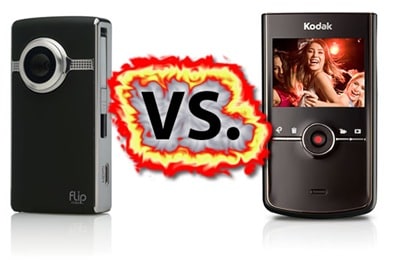
I don’t have the luxury of having a gadget expense account. All that I have to rely on is the kindness of vendors and PR firms to supply me with either loans or donations of the latest and greatest technology gear. For the most part, because of my technology passion, coupled with the fact that I have about 3 years of doing gadget reviews under my belt, I guess that I have a bit of a gadget reputation. Regardless, I turned to Twitter to help with this review, specifically getting these two HD cameras. I love the power of Twitter. While it took a few weeks, the end result was that I can now use either the Zi8 or the UltraHD in my future product reviews (as well as filming some family movies on the side). A special thanks goes out to both the Flip and Kodak folks (and their PR firms) for graciously donating these devices to me for use in my future product reviews and event coverage.
The Flip UltraHD
 Flip has done a great job creating a strong marketing image for themselves. They present the various Flip Video lines as lifestyles, and with many different models available, complete with skin and feature customizations, there is a model for everybody. When I reviewed their site, the UltraHD was the one that stood out in my opinion. I wanted a high definition recorder that could hold a few hours of video, all from a compact, easy to use device.
Flip has done a great job creating a strong marketing image for themselves. They present the various Flip Video lines as lifestyles, and with many different models available, complete with skin and feature customizations, there is a model for everybody. When I reviewed their site, the UltraHD was the one that stood out in my opinion. I wanted a high definition recorder that could hold a few hours of video, all from a compact, easy to use device.The Flip UltraHD comes with the camcorder, a rechargeable battery pack, wrist strap, soft case and a quickstart guide. Also, there is no need to buy a SD media card to store your videos as it comes with storage (8 GBs). Within the storage is also the FlipShare software that lets you easily manage your videos, create movies, take snapshots from videos and share your videos with various communities.
Setting up the UltraHD is very easy (and you can tweak any of the settings later by holding down the bright red button when the Flip is starting up).
 You scroll through the setting up of date and time and some other items and you are pretty much up and running after a few seconds. One thing that I do like in the settings is that you can not only disable the “be-beep” (proprietary?) sound of the Flip recording, but you can also disable the red recording light on the front of the Flip. This feature is important when you are trying to keep interviews or conversations with people casual. People tend to perform when they see the red light (at least my kids do) or get shy or nervous when confronted with the ominous red light.
You scroll through the setting up of date and time and some other items and you are pretty much up and running after a few seconds. One thing that I do like in the settings is that you can not only disable the “be-beep” (proprietary?) sound of the Flip recording, but you can also disable the red recording light on the front of the Flip. This feature is important when you are trying to keep interviews or conversations with people casual. People tend to perform when they see the red light (at least my kids do) or get shy or nervous when confronted with the ominous red light.When powered, the 2” display screen is bright and easy to see. There is also an indicator of the amount of time remaining in storage. Storage itself is 8 GB which can hold about 120 minutes of 16:9 720P HD video. Once a movie is recorded, it can be played back on the view screen. You use the right and left arrows to navigate through each of the recorded scenes. You also have the ability to do playback on an HDMI compatible device. Note that there is not an HDMI cable provided and that the cable is an HDMI mini cable, not standard.
 Videos are also downloaded easily via a USB connector. On the side of the UltraHD is a button that, when pulled down, flips out a USB connector like a switchblade. Simply plug the USB into either a Mac or PC to mount the Flip as a USB drive. You also have the ability to install the FlipShare software. The FlipShare Software installers for both Mac and PC are within the device (or you can download from the Flip site) so there is no installer CD included with the packaging.
Videos are also downloaded easily via a USB connector. On the side of the UltraHD is a button that, when pulled down, flips out a USB connector like a switchblade. Simply plug the USB into either a Mac or PC to mount the Flip as a USB drive. You also have the ability to install the FlipShare software. The FlipShare Software installers for both Mac and PC are within the device (or you can download from the Flip site) so there is no installer CD included with the packaging.The FlipShare software contains the very basic functionality for downloading, managing and sharing your recorded HD media. The features and look and feel are consistent cross-platform and since the software remains with the Flip, you can install it on any computer that you need to. This is a very handy feature. Very rudimentary movies can be created using the FlipShare software. Below is a series of screens that show the 4 steps to create a movies with a title, multiple HD movies, credits and music. The process only takes a few minutes (depending on the length of the videos).

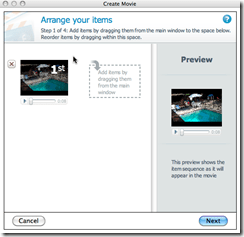
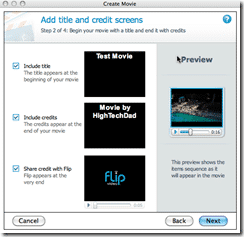
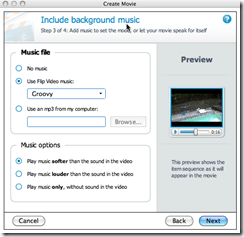
You also have the ability to share your content via email, greeting cards or online, as well as through a service called the “Flip Channel”. This is essentially a community of Flip video users where people can create and share the movies they created on the Flip.
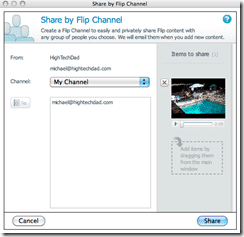
Your movies are easily organized within folders grouped by dates within the FlipShare software. While the software features are very basic, they do their job quite well.
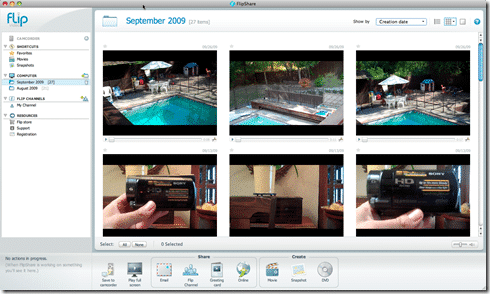
I like the fact that the Flip UltraHD can stand up on its own when placed on a level, flat surface and doesn’t need a tripod for hands-free operation. It is not always ideal to lug around a tripod or Gorillapod (a very cool tripod that has flexible legs/arms that can be wrapped around just about anything stationary or on uneven surfaces). The UltraHD works best when filming in bright light and of items in a distance. I don’t recommend using it for low-light or product close-ups. It’s great for family get-togethers or snapping quick HD videos of events. Think of it as a simple point-and-click camera versus a digital SLR (where the digital SLR would be a higher end HD camcorder like the Sony HDR-XR500).
Overall, the Flip UltraHD seems to be a reliable portable HD camcorder. It’s a good entry-level camera that can do a majority of what an average family might want in a portable camcorder. It feels solid enough to give to a kid to use, yet produces quite good HD recording.
The Kodak Zi8
 I received the Kodak Zi8 about a month after the Flip. I had tried to stay clear of reading other reviews (a policy that I stand by in order to keep my own reviews as unbiased as possible). I had, however, looked over the product pages and mentioned that I would testing the Zi8 on Twitter. The tweets that came back to me were very positive for the Zi8. Even during the Apple iPod event, when Apple announced the new iPod Nano with the “free” video recorder in it, the feedback was positive.
I received the Kodak Zi8 about a month after the Flip. I had tried to stay clear of reading other reviews (a policy that I stand by in order to keep my own reviews as unbiased as possible). I had, however, looked over the product pages and mentioned that I would testing the Zi8 on Twitter. The tweets that came back to me were very positive for the Zi8. Even during the Apple iPod event, when Apple announced the new iPod Nano with the “free” video recorder in it, the feedback was positive.As the Apple iPod Nano was announced, I tweeted out “The new Nano doesn’t do HD so I’m sticking with Flip UltraHD (and possibly Kodak Zi8)“. Within a few minutes, Robert Scoble (avid, blogger, vlogger, who I have met a few times and who I knew was a Flip Video user in the past), tweeted out “The new Nano doesn’t do HD @HighTechDad says. I agree, big winner is Kodak here. The new Zi8 totally rocks.“. That response plus a few other tweets I had seen started to convince me that that the Kodak was going to be a big contender for the leadership spot.
I was very excited when I received the Zi8. It is slightly larger in length and width than the Flip UltraHD but its thickness is a bit less (0.9 inches vs. the Flip’s 1.17 inches). It also has less of a boxy look than the Flip and the surface is much more glossy and polished (the UltraHD is more of a matted color and material). When you have glossy surfaces, fingerprints tend to stand out, which they do on the Zi8. Not a huge deal since a soft cloth wipes it clean.
The Kodak Zi8 comes with the camcorder, Kodak Li-ion rechargeable battery, HDMI & A/V cables, user guide and wrist strap.
One thing that the Zi8 does NOT come with is a SD or SDHC card. I found this to be really annoying as the 128 MB internal storage is good for about 3 seconds of HD video, hardly long enough to test. So I had to order an SDHC card from Amazon. Luckily, these types of cards abound. You probably should look for a Class IV (search) or Class VI (search) as they will perform a bit better supposedly. I picked up a Transcend 16 GB SDHC Class 6 card for about $38 from Amazon. It is convenient to be able to immediately record with the Flip right out of the box I must say. But in retrospect, having the ability to quickly and easily swap out SD/SDHC cards makes the Zi8 a bit more appealing.
The screen on the Zi8 is about 2.5″ diagonal, is clear, crisp and bright. Sound quality from the speakers is tinny (like the Flip) but you do get full audio and video playback on both devices.
Like the Flip, the Zi8 has a series of buttons on the
 back including a red one that is for initiating recording. However the button is also a joystick that allows you to navigate and zoom (when the camera is active). On the Flip, you use the navigation buttons that surround the big red button for zooming and other functions. The Kodak has 4 other buttons (Settings, Trash, Video and Playback) that are dedicated. The Flip has Play and Trash buttons only (which serve as multi-function buttons).
back including a red one that is for initiating recording. However the button is also a joystick that allows you to navigate and zoom (when the camera is active). On the Flip, you use the navigation buttons that surround the big red button for zooming and other functions. The Kodak has 4 other buttons (Settings, Trash, Video and Playback) that are dedicated. The Flip has Play and Trash buttons only (which serve as multi-function buttons).Like the Flip, the Kodak has a pop-out USB connector. However, instead of being a rigid arm, the Zi8′s has one that is flexible and has a bit of a give to it. This is particularly handy if you are using a laptop that sits flat on a desk (although mine are raised using various USB cooling fans). The Flip’s is solid and I was a bit worried about bending or breaking it as I connected it to a free port. Both the Flip and the Kodak seemed to function fine on both the high-powered and low powered USB ports on my MacBook Pro. Also, both the Flip and the Kodak use the USB connection to charge the internal batteries. The Kodak, though, does include a handy USB wall charger which is great if you don’t have your laptop or computer with you.

A few other nice features that are built into the Zi8 is their “smart face tracking” technology which is supposed to ensure good lighting when it recognizes faces. Also, the Zi8 supposedly has better low-light capabilities which is useful when filming in a dark room or at dusk. Lastly, the Zi8 also functions as a 5.3 MP still camera (on the Flip, you have to use the included software to take snapshots from videos). This is very handy to have and eliminates the need to have to carry around another point-and-click camera. Note though that there is no flash built in so it is only good for well-lit shots. There is a 4x digital zoom (compared to the 2x digital zoom on the Flip) which works fairly well but in lower light situations, it can get a bit grainy and pixilated. Lastly, there is the option to connect an external microphone (stereo) which is a nice add-on, especially for face-to-face interviews and such. (I have not tested this yet.)
Kodak chose to use ArcSoft’s MediaImpressions for their PC video management software. For the Mac user, they simply relied on iPhoto for managing the video and photos (which was fine by me). Below are some screenshots of MediaImpressions in action. You are initially greeted with some basic sharing and management functions:
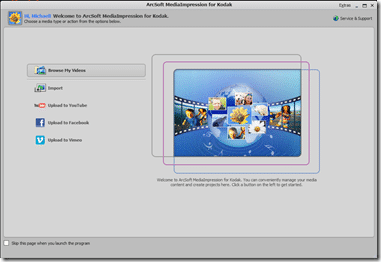
Once you download your videos from the Zi8, you can manage them (and other media) through the interface. You can tag videos and categorize them fairly easily. The ArcSoft software is contained within the Zi8 so you can install easily on any computer.
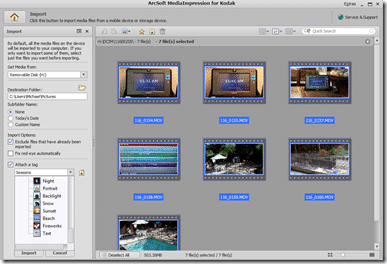
Creating a quick movie is just as easy as on the Flip. There are a few more functions (like themes) and the places you can easily share to (like YouTube, Facebook, Vimeo and others) as well as the ability to quickly archive to DVD.

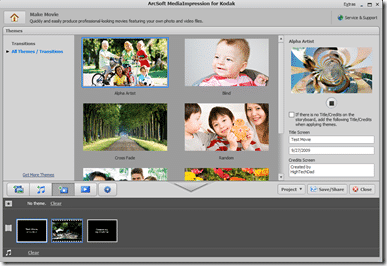
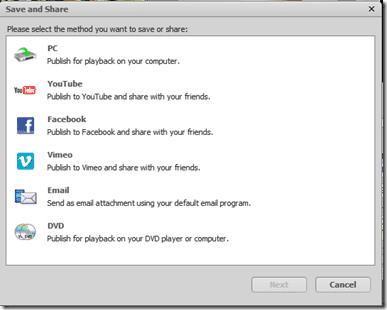
Lastly, MediaImpressions has the ability to convert and export your videos to other devices like Sony PSPs or Apple iPods/iPhones.
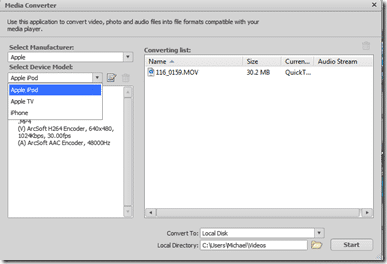
Overall, I found the Kodak Zi8 to be excellent in terms of its features and capabilities. My only complaints were that you can’t stand it on a table (like you can with the Flip) and that it doesn’t come with a SD card (even a 4 or 8 GB SD card would have been nice). The picture quality and audio are both quite good. It seems to me that the Kodak team took the Flip and tried to improve on some of the features therein. I view the Zi8 as more of a “business” device, with a bit more configurability (e.g., you can choose the different HD formats on the fly: 1080p/30 frames per second, 720p/60fps, 720p/30fps, WVGA/30fps and still shots/camera mode). While it is hard to notice the difference quickly, more careful viewing of the output reveals crisper details and better panning, especially when using the 60fps option.
Head to Head
I have a feeling that this market of portable HD video cameras will start to get cluttered over the next year or so. Flip was probably the first big entrant into the space, at least the one that did so with the most splash and recognition. Since then, other competitors have arrived with good fanfare including the Kodak Zi6, the Samsung HMX-U10, the Kodak Zi8 and most recently, Apple’s iPod Nano (although the Nano doesn’t really fall into the category that well since it doesn’t record HD video). I would have liked to include the Samsung in this comparative review but unfortunately I don’t have access to one.
One of the best ways to compare these two devices is to simply look at the specs side-by-side:
| Flip UltraHD | Kodak Zi8 | |
| Sensor Type | 1/4.5″ HD 2.2 MP CMOS | 1/4.5-type 1.6 MP CMOS |
| Lens | f/2.4 | 6.3mm, f2.8 fixed focus 35 mm equivalent: 61 mm (1080p), 46 mm (720p/60fps, 720p, WVGA), 42 mm (still) |
| Zoom | 2x digital | 4x digital |
| Display size | 2 inches | 2.5 inches |
| Storage | 8GB | 128 MB internal, SD/SDHC expansion card slot |
| Focus Modes | Fixed Focus | normal/macro |
| Focus Range | 1.5m to infinity | normal: 100cm – infinity/macro: 15cm |
| White Balance | auto | auto |
| File Formats | H.264, AAC MP4 | video: H.264(MOV), AAC LC; still: JPEG |
| Capture Mode(s) | 720p (1280×720,30 fps) | 1080p (1920 × 1080, 30 fps) 720p/60 fps (1280 × 720, 60 fps) 720p (1280 × 720, 30 fps) WVGA (848 × 480, 30 fps) Still (5.3 MP, 16:9 widescreen, interpolated) |
| Microphone | wide-range stereo microphone | yes (monaural) |
| Speaker | yes | yes |
| I/O interfaces | USB 2.0 (high speed) HDMI | USB 2.0 (high speed) AV out HDMI DC in external mic jack (stereo) |
| Battery | Flip Video AA rechargeable battery pack (1.2 volt NiHM) | KODAK Li-ion Rechargeable Digital Camera Battery/AC adapter |
| Dimensions (l x w x h) | 4.25 x 2.19 x 1.17 inches | 4.5 x 2.4 x 0.9 inches |
| Weight | 6.0 oz | 3.9 oz (w/o batteries) |
| MSRP | $199.99 | $179.95 |
| Current Amazon Price (on 9.30.09) | $161.98 – Amazon link | $179.95 – Amazon link |
Summing up the Good & the Bad
Both the Flip UltraHD and the Kodak Zi8 fill the need for portable HD video recorders. They both have small form factors and produce great quality video images. They are extremely easy to use and each have their own software for managing movies, creating content and sharing with a variety of sources. At around the same price point, each device is worthy of being on a shortlist of gadgets to get for your family. The Amazon price for the Flip UltraHD makes it currently slightly more reasonable than the Zi8, but if you weigh in the items I mentioned above as well as the bullets below, you might want to consider the Kodak Zi8 as the leading candidate. Quickly:
- Tripod-less: The Flip stands up on its own, Kodak needs a tripod. Both have tripod connectors. Winner: Flip
- Focus: Both have auto focus. However the Zi8 has a Macro focus for close-ups. Winner: Kodak
- Microphone: Both have built in mics. Zi8 has a jack for an external stereo mic. Winner: Kodak
- Price: MSRP has the Zi8 slightly less, however discounts for Flip exist and newness of Kodak come into play. Look at features!. Winner: TIE
- Lens: While it is nice that the UltraHD has glass covering the lens, it is very easy to smudge it with fingerprints. Zi8 has recessed lens. Winner: Kodak
- USB connector: Both devices have pop-out USB connectors. Flip’s is rigid and Zi8 is flexible. Winner: Kodak
- HDMI: Both have HDMI out – with the Flip, you must purchase an extra cable; with Kodak it is included. Winner: Kodak
- Zoom: There is a 2x digital zoom on the Flip and a 4x digital zoom on the Kodak. Winner: Kodak
- Video formats: The Flip has 1 HD format only. The Kodak has 3 plus 1 non HD and stills. Winner: Kodak
- Camera: With the Flip, you need to use the software to “take pictures” from a video. The Kodak actually has a “camera mode” built in on. Winner: Kodak
- Image Stabilization: Don’t drink coffee with the Flip. Stabilization is built in on the Zi8. Winner: Kodak
- Storage: The Zi8 uses a removable SD card which is not include but is useful if you want to carry multiple cards. The Flip’s is internal so you are good to go from the start. Winner: Your choice
- Picture Quality: It’s a bit too soon for me to really judge this. In some quick initial tests, the Zi8 seemed to have better color balance. Winner: Still evaluating
- Power Up Time: Both seemed to have the same power-up times of about 2 seconds or less (which is GREAT!). Winner: TIE
- Community: While sharing is built into both, the Flip Channel community seems much stronger. Winner: Flip
Source for the above

No comments:
Post a Comment